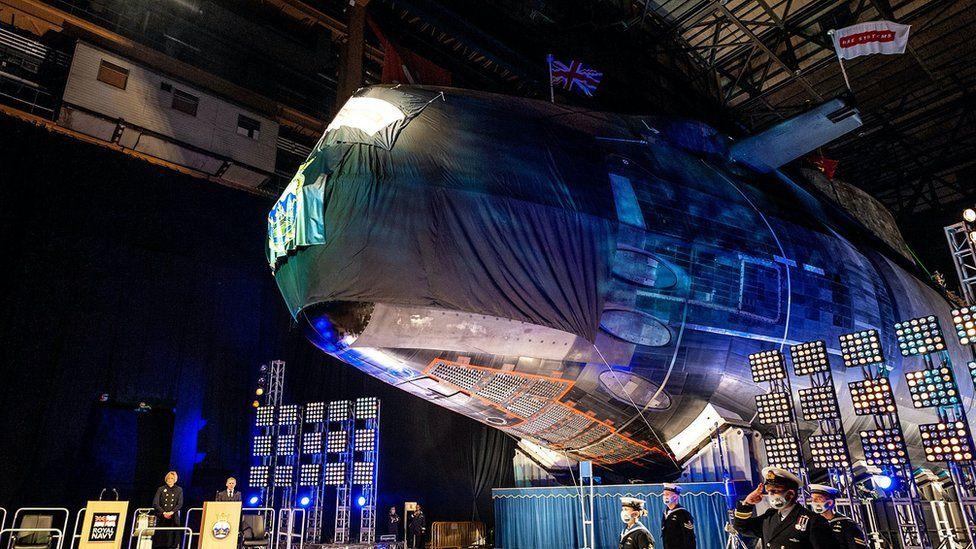Africa-Press – Kenya. By Michael DempseyTechnology of Business reporter
On 20 April, the Royal Navy’s latest nuclear-powered hunter-killer submarine, HMS Anson, emerged from a vast construction hall at Barrow-in-Furness, and was hoisted into the water. All 7,400 tonnes of it.
Around 260 miles away in Plymouth, another submarine made its debut that same day. A minnow compared to HMS Anson, this secretive nine-tonne craft may have greater implications for the future of the navy than the £1.3bn nuclear boat.
MSubs of Plymouth, a specialist in autonomous underwater vehicles, won a £2.5m Ministry of Defence contract to build and test an Extra-Large Unmanned Underwater Vehicle (XLUUV) that should be able to operate up to 3,000 miles from home for three months.
The big innovation here is the autonomy. The submarine’s movements and actions will be governed entirely by Artificial Intelligence (AI).
Ollie Thompson is a recent graduate who is studying for a master’s degree in robotics at Plymouth University. He also works for MarineAI, the MSubs arm that is fitting out the XLUUV’s brain.
Mr Thompson has no doubts about the challenge he and his colleagues face: “We know a lot of people don’t have confidence in AI. So we work with elements we can test, we separate things into boxes.”
He divides the AI problem into components – and mission management is the toughest. This attempts to simulate the presence of a trained captain in the little submarine’s programming.
This is AI working in total isolation from human contact, not least because maintaining strict radio silence is critical to a submarine’s covert role. The technical principle here is machine learning, showing an AI program examples of how a task should be performed until it has embedded the right actions in its own repertoire.
To do this, MarineAI is using a huge IBM AC922 supercomputer, “a monster, one of the biggest in the South-West of England” Mr Thompson boasts. In contrast the on-board brain of the submarine resides in a 15cm square box and relies on an Nvidia chip often found driving computer games.
“We built it off the back of the Nvidia chip because it’s highly energy efficient,” says Mr Thompson. Just like a tiny but powerful Raspberry Pi device used to teach schoolchildren basic programming tasks this approach takes up very little power. And keeping power consumption to the bare minimum is critical to making the submarine’s battery last.
It’s clear that the Ministry of Defence is paying very close attention to battery technology for this project. So far MarineAI is relying on existing technology derived from car batteries. But it notes that research in this field is leaping forward.
The AI content of the computer should prioritise tasks. The project envisages a boat that can travel to an area of the sea-bed to search for mines or plant a sophisticated electronic intelligence-gathering package or stay in place and scour its environment for information on a hostile navy.
So MarineAI is creating a decision-making capacity for the submarine’s brain. It will know how much battery life is left and how to weigh that against prevailing weather conditions and sea states, reaching a logical decision on whether to sail on or return home in the face of strong tides.
The project has oceans left to cross. For instance, how can the submarine detect small objects on the surface such as jet-skis?
All of these dilemmas are small beer for human submarine captains. Commander Ryan Ramsey captained the hunter-killer HMS Turbulent and taught on the Perisher, a five-month-long course the navy uses to push prospective submarine skippers to the limit.
This decides if they are fit to command 100 or more submariners working punishing watches consisting of six hours on, six hours off for the duration of a long patrol.
Cdr Ramsey worked in AI after leaving the navy and can see where smart software and human instinct might not produce the same response.
“AI will struggle to match human decision-making skills. There are lots of submariners skills you can transfer to it, but you have to accept that the first generation will not be perfect.”
He cites how he would study opposing Nato submarine commanders he went up against in exercises, learning how far each individual was prepared to push a vessel. “The reality is that if you don’t know how a guy operates he will find your submarine before you find him. You can’t replicate that emotional input in AI.”
If the XLUUV is ever to be armed that might create serious problems. The decision to fire a torpedo rests on a huge reserve of each officer’s instincts and experience. “If you leave that to a rules-based system you might escalate things. There is just so much to learn about the underwater battlespace.”
In the future Cdr Ramsey believes submarines will be equipped with the ability to launch their own autonomous vessels. The next generation of surface warships entering service are already planned to feature mission-bays for launching uncrewed vessels. And autonomous submarines can be deployed by transport aircraft, giving the batteries a rest and the XLUUV a global reach.
The longer-term prospect for AI-controlled submarines is rosy, says Cdr Ramsey. “I can see a way to do a Perisher for AI. Get the right people to recreate their experiences in a simulator and let the AI learn from that, including human decisions that might be wrong. Give it ten years’ worth of data and it will be able to build its own rules.”
This simulator-based course for computer code promises another big benefit. “The AI can test out its own rules without any risk. My worry with autonomous submarines is the political impact if the vessel does something wrong or gets caught in hostile waters,” he says.
Plymouth’s trial submarine is based on an MSubs design known as the S201. And across the Atlantic, Boeing is building a series of large uncrewed submersibles as the US Navy works out how these vessels can be used.
Former submariners talk about the degree of teamwork and close comradeship required to perform their missions. AI cannot replicate this, but it does not need to if all it is doing is saving sailors from exhausting and repetitive tasks better allocated to a drone.
The Royal Navy is coy about its plans for this technology and is committed to a next generation of crewed nuclear submarines. Yet the work of Plymouth’s AI pioneers may see their most perilous missions delegated to an AI program that never goes off watch.






